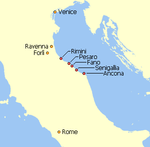- Duchy of the Pentapolis
-
Duchy of the Pentapolis Duchy of the Byzantine Empire 554 – ca. 752 The Pentapolis on the Adriatic was part of the Exarchate of Ravenna, an administrative unit of the Byzantine Empire. Red dots indicate the Pentapolis, orange other cities of the Exarchate. Capital Rimini Historical era Middle Ages - Establishment under the authority of the Praetorian Prefect of Italy 554 - Part of the Exarchate of Ravenna 584 - Conquered by Lombard king Aistulf ca. 752 In the Byzantine Empire, the Duchy of the Pentapolis was a duchy (Latin: ducatus), a territory ruled by a duke (dux) appointed by and under the authority of the Praetorian Prefect of Italy (554–584) and then the Exarch of Ravenna (584–751). The Pentapolis (from the Greek term πεντάπολις, "five cities") consisted of the cities of Ancona, Fano, Pesaro, Rimini and Sinigaglia. It lay along the Adriatic coast between the rivers Marecchia and Misco immediately south of the core territory of the exarchate ruled directly by the exarch (the Ravennate), east of the Duchy of Perugia, another Byzantine territory, and north of the Duchy of Spoleto, which was part of the Lombard Kingdom of Italy (founded in 568). The duchy probably extended inland as far as the Apennine Mountains, perhaps beyond, and its southernmost town was Humana (Numera) on the northern bank of the Misco.[1] The capital of the Pentapolis was Rimini and the duke was both the civil and military authority in the duchy.[2]
The Pentapolis was one of the more commercially vibrant parts of Italy. The citizens of the Pentapolis tried constantly to reduce the authority of the exarch in the duchy, while Byzantine Italy generally experienced a general decentralisation during the seventh century.[3] In 725, when the Exarch Paul wanted to lead a punitive expedition against the Duchy of Rome, where Pope Gregory II and the citizens had usurped imperial prerogatives and deposed and replaced the reigning duke, he raised troops in the Ravennate and the Pentapolis. The Lombard historian Paul the Deacon says that he had great difficulty in raising the necessary troops and his expedition was ultimately a failure.[4] In 726, the iconoclasm of Emperor Leo III the Isaurian (r. 717–741) first became public, possibly even through an edict against sacred images. The inability of the exarch to impose his authority in Rome and his weakness in the Pentapolis was transformed into impotence when the "armies", that is, the Roman military aristocracies, of the duchies of the Ravennate, the Pentapolis, and Venetia rose in revolt declaring that they would protect the pope from the imperial decree, which Paul had been ordered to enforce throughout Italy (727).[4]
In 738, the Lombard king Liutprand marched through the Pentapolis on his way to Spoleto, and during his transit was attacked by a group of "Spoletans" (Lombards from central Italy) and "Romans" (local Pentapolitans). The locals may have been incited to this alliance against Liutprand by the exarch, Eutychius, who may have had a deal with the duke of Spoleto, Transamund II.[5] The Pentapolitans were not traditionally on good terms with either the Byzantines, whom Liutprand fought in 728–729, or the exarch in Ravenna, whom Liutrpand also fought frequently, but they were unlikely to regard Lombard incursions in their region as a "liberation".[6] Liutprand attacked Ravenna and Cesena on the via Aemilia in 743, probably with the goal of controlling a passage through Byzantine territory to Spoleto. His successor, Ratchis, attacked several cities in the Pentapolis and Perugia in 749, before retiring to become a monk.[7] By 752, the Pentapolis was conquered by King Aistulf of the Lombards.[8]
References
- ^ Hallenbeck 1982, p. 7.
- ^ Hutton & Sund 1913, p. 119.
- ^ Noble 1984, pp. 3–5.
- ^ a b Noble 1984, pp. 29–30. The events of 725–727 in the Exarchate are recorded in the Liber pontificalis, a collection of papal biographies; the Chronicon Venetum of John the Deacon, a Venetian historian; the Historia Langobardorum of Paul the Deacon; and the much later Chronicon of the northern European historian Regino of Prüm.
- ^ Noble 1984, p. 44.
- ^ Noble 1984, p. 35.
- ^ Noble 1984, pp. 56–58.
- ^ Noble 1984, p. 71.
Sources
- Hallenbeck, Jan T. (1982). "Pavia and Rome: The Lombard Monarchy and the Papacy in the Eighth Century". Transactions of the American Philosophical Society (Philadelphia, Pennsylvania) 72 (4): 1–186.
- Hutton, Edward; Sund, Harald (1913). Ravenna: A Study. London, United Kingdom and Toronto, Canada: J. M. Dent and Sons Ltd. http://books.google.com/books?id=ousbAQAAMAAJ.
- Noble, Thomas F. X. (1984). The Republic of St. Peter: The Birth of the Papal State, 680–825. Philadelphia, Pennsylvania: University of Pennsylvania Press. ISBN 0812212398. http://books.google.com/books?id=UpUi7DAWSX0C.
Further reading
- Diehl, Charles (1888). Études sur l'administration byzantine dans l'Exarchat de Ravenne (568–751). 53. Paris, France: Bibliothèque des écoles françaises d'Athènes et de Rome. http://books.google.com/books?id=tbUZAAAAYAAJ.
- Paul the Deacon; Foulke, William Dudley (trans.) (1974) [1907] (PDF). The History of the Langobards. Philadelphia, Pennsylvania: University of Pennsylvania. http://www.thule-italia.org/Nordica/Paul%20the%20Deacon%20-%20History%20of%20the%20Lombards%20%281907%29%20%5BEN%5D.pdf.
Categories:- Provinces of the Byzantine Empire
- 6th century in the Byzantine Empire
- 7th century in the Byzantine Empire
- 8th century in the Byzantine Empire
- Exarchate of Ravenna
Wikimedia Foundation. 2010.

